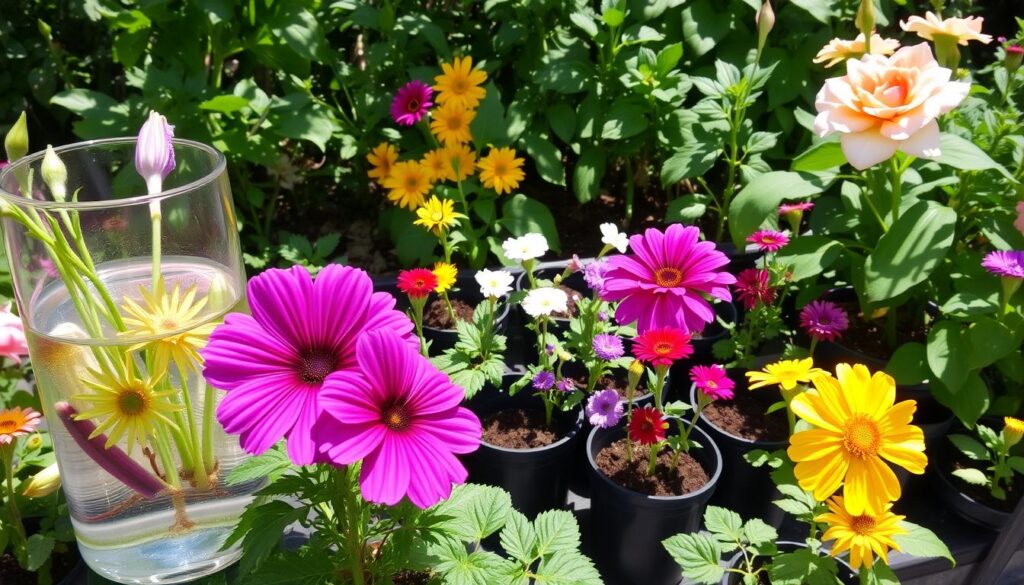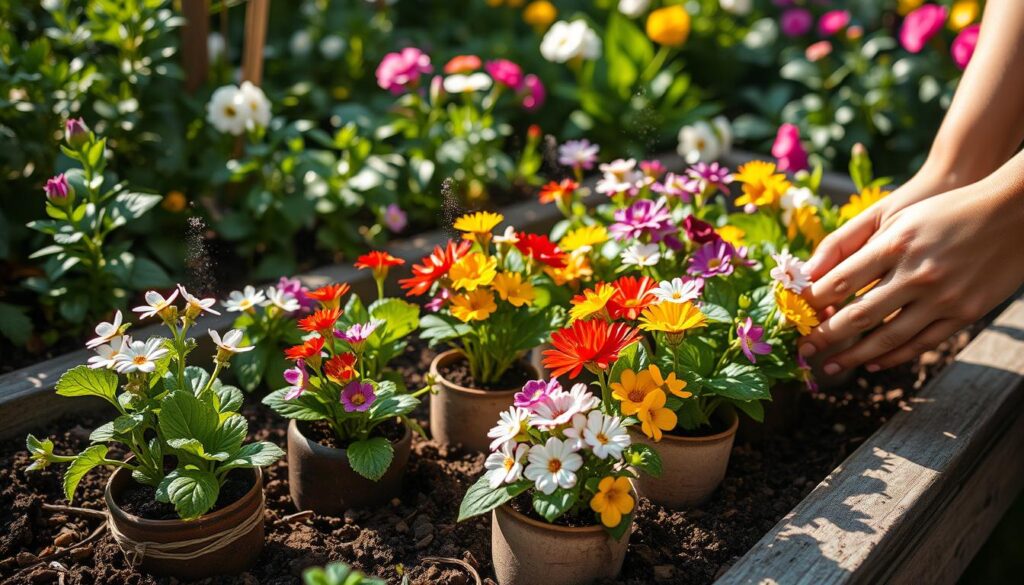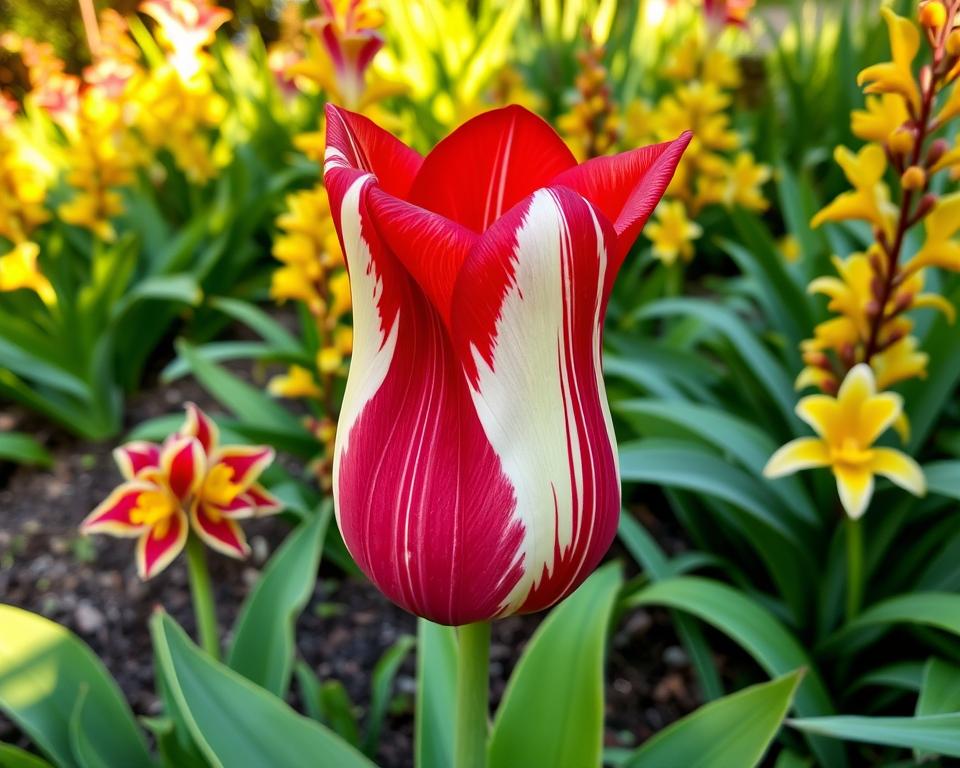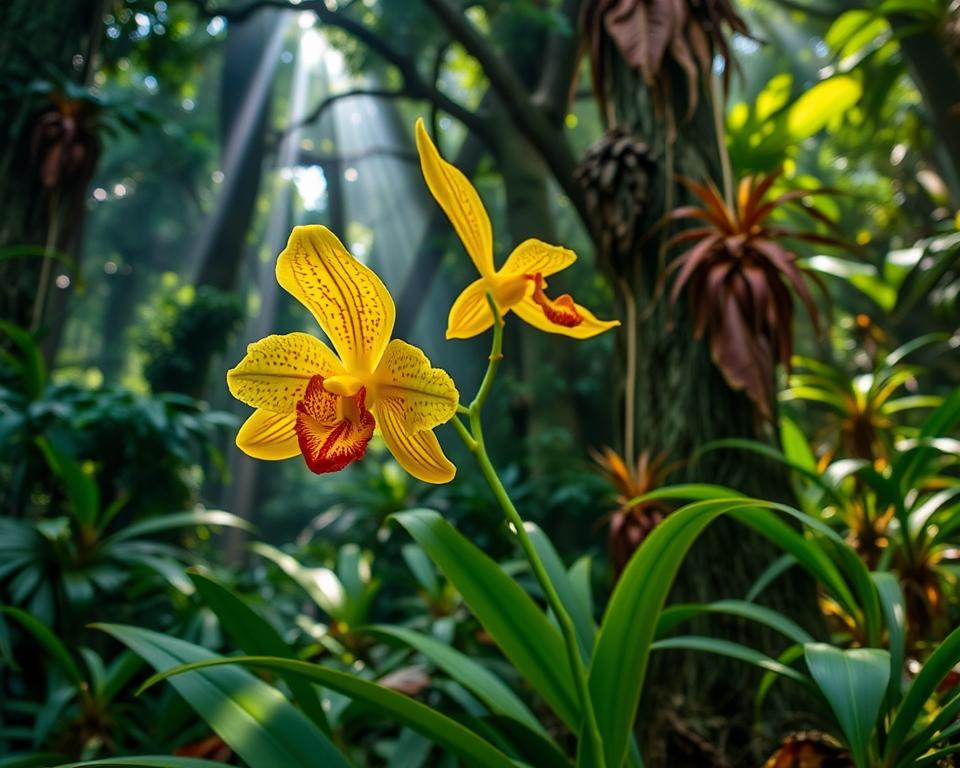How to propagate flowers in a simple and practical way

Propagating flowers is fun and rewarding. It lets gardeners grow their favorite blooms and share them. To do this easily, you need to know the basics of flower propagation.
There are two main ways: growing from cuttings or seeds. This can help you grow your garden and enjoy nature’s beauty. With the right tools and techniques, anyone can propagate flowers and enjoy their benefits.
Learning to propagate flowers can save money and share plants with loved ones. It’s also fulfilling to grow your own flowers. Whether you’re new or experienced, it’s a simple way to beautify your garden.
In this guide, we’ll cover different methods of flower propagation. We’ll talk about growing from cuttings and seeds. Plus, we’ll share tips and tricks for success.
Understanding Flower Propagation Basics
Flower propagation lets gardeners make new plants from old ones. It’s a wonderful way to share plants with loved ones.
The flower propagation basics cover different ways to do it, like using seeds, cuttings, or dividing plants. Knowing these methods helps gardeners pick the best one for them.
There are many types of flower propagation, each with its own good and bad points. Here are a few:
- Seed propagation: This means planting seeds in a tray or directly in the garden.
- Cutting propagation: It’s about taking pieces from a grown plant and making them root in water or soil.
- Division: This is when you split a big plant into smaller parts and replant them.
The benefits of flower propagation are many. Gardeners can make new plants cheaply and keep their favorite plants’ traits. It also lets them share plants, helping with biodiversity and conservation.
By learning about flower propagation, gardeners can grow more plants and enjoy a wider variety of flowers.
| Method | Advantages | Disadvantages |
|---|---|---|
| Seed propagation | Low cost, easy to do | Can be time-consuming, may not produce identical plants |
| Cutting propagation | Fast results, can produce identical plants | May require specialized equipment, can be more expensive |
| Division | Preserves genetic traits, can be done at home | May be more difficult, requires mature plants |
Choosing the Right Flowers to Propagate
Choosing flowers for propagation involves several key factors. One major decision is whether to pick perennials or annuals. Perennials grow back every year, while annuals complete their life cycle in one season.
Choosing flowers for propagation means weighing the benefits of each type carefully.
Perennials, like daylilies and coneflowers, are perfect for beginners. They’re easy to care for and can be split to propagate. Annuals, however, are often grown from seeds or cuttings. Beginner-friendly options include zinnias, marigolds, and petunias.
Perennials vs. Annuals
Here are some key differences between perennials and annuals to consider when choosing flowers for propagation:
- Perennials: come back year after year, often require less maintenance, and can be propagated through division
- Annuals: complete their life cycle in a single growing season, often require more maintenance, and can be propagated through seeds or cuttings
Suitable Flower Varieties for Beginners
Some popular flower varieties for beginners include:
- Zinnias: easy to propagate through seeds and come in a variety of colors
- Marigolds: easy to care for and can be propagated through seeds or cuttings
- Petunias: easy to propagate through cuttings and come in a variety of colors
Tools and Supplies Needed for Propagation
To start propagating flowers, you need the right propagation tools and supplies. This includes pruning scissors, a potting bench, and a watering can. Having these essential supplies makes the process easier and boosts success chances.
Choosing the right recommended soil is key. It should drain well and be full of nutrients. This prevents waterlogged soil and root rot, which harm plants. Also, pick clean, sterile containers with drainage holes to avoid water buildup.
Other tools and supplies you’ll need are:
- Seed trays or cell packs
- Potting mix
- Fertilizer
- Pruning tools
- Watering can or spray bottle
With these propagation tools and supplies, gardeners are ready to start growing their own flowers. The right essential supplies, including recommended soil and containers, make propagation easier and more successful.
| Tool/Supply | Description |
|---|---|
| Pruning scissors | Used to cut and trim plant stems |
| Potting bench | A surface for potting and repotting plants |
| Watering can | Used to water plants and seedlings |
Propagating Flowers from Cuttings
Many gardeners love propagating flowers from cuttings. It’s a way to grow new plants that look just like the original. When selecting healthy cuttings, look for stems with lots of leaves and a strong base.
Selecting the Right Cuttings
To boost your chances of success, keep these tips in mind:
- Choose cuttings with at least two nodes
- Select cuttings from healthy, disease-free plants
- Take cuttings in the morning, when the plant is at its highest water content
Water Propagation vs. Soil Propagation

There are two main ways to propagate flowers from cuttings: water propagation and soil propagation.
Water propagation means putting the cutting in a glass of water. This lets the roots grow before moving it to soil. Soil propagation, however, involves planting the cutting straight into soil.
Both methods work well, depending on the flower type and your preference.
By following these steps and choosing the right method for your flower, you can grow new plants. Enjoy a beautiful garden with your own efforts.
Propagating Flowers from Seeds
Seed propagation is a rewarding and cost-effective way to grow new flowers. First, you need to harvest seeds from flowers.
This means letting the flowers mature and dry, then collecting the seeds from the seed pods or heads. It’s important to do this correctly for successful seed propagation.
After harvesting, you need to sow the seeds. You can do this indoors or directly in the garden, depending on the flower type and season. When sowing seeds, use a well-draining mix and ensure the soil is moist and gets enough light.
Germination tips vary by flower type, but generally include keeping the temperature steady and the soil moist.
- Using fresh and high-quality seeds
- Providing the right amount of light and water
- Maintaining a consistent temperature
- Being patient and allowing the seeds time to germinate
By following these tips and understanding seed propagation, you can grow new flowers from seeds.
Division as a Propagation Method
Dividing flower plants is a simple and effective way to propagate new plants. This division method involves separating a mature plant into smaller sections.
Each section has its own roots and growth nodes. This way, you can create multiple new plants from a single parent plant.
When it comes to dividing flower plants, timing is everything. The best time to divide plants is during their dormant season. This is when they are not actively growing.
It reduces the risk of shocking the plant and helps it focus on establishing a strong root system.
When to Divide Flower Plants
The ideal time for division depends on the type of plant and its growth cycle. Spring-blooming plants are best divided in the fall. Fall-blooming plants are best divided in the spring.
Step-by-Step Division Process
To divide a plant, follow these steps:
- Water the plant thoroughly the day before division to make the soil easier to work with.
- Dig up the entire plant, taking care not to damage the roots.
- Gently separate the roots, working from the bottom up.
- Replant the divided sections, making sure each new plant has a sufficient amount of soil and water.
By following this step-by-step division process, you can successfully propagate new plants using the division method. Remember to provide your new plants with proper care. This includes adequate water, sunlight, and nutrients to ensure they thrive.
Using Layering for Flower Propagation
Layering is a way to grow new flowers by bending a stem to the ground. This method works well for long-stemmed plants like roses and shrubs. To do layering, you need patience and to pay close attention to every detail.
The layering technique has a few steps. First, pick a healthy stem. Then, remove leaves from the bottom part. Next, tie the stem down with a rock or a U-shaped wire.
Make sure the soil stays moist to help roots grow. With the right care, you can get a new plant from the parent plant.
For successful layering, choose a stem that’s long enough to reach the ground. Make a small cut on the stem to help roots grow. Keep the soil warm and humid. By following these tips, you can grow new plants in your garden.
Here are some benefits of using the layering technique:
- High success rate
- Low cost
- Easy to perform
Understanding Rooting Hormones
Rooting hormones are key in growing new plants from cuttings. They help roots grow, making it more likely for plants to thrive. These substances, whether natural or made, mimic how plants naturally grow roots.
To use rooting hormones well, you can dip cuttings in a powder or liquid. This step boosts the chance of roots forming. It leads to a strong and healthy plant.
When using rooting hormones, consider the plant type, hormone strength, and how you apply it. Always follow the product’s instructions for safe and best results.
- Choose the right type of rooting hormone for the plant species
- Follow the instructions for application and concentration
- Ensure the cutting is healthy and free of disease
- Provide the right conditions for root growth, including adequate light and water
Knowing about rooting hormones and how to use them can help gardeners succeed. With the right tools and knowledge, anyone can grow new plants from cuttings.
Seasonal Considerations for Flower Propagation
When it comes to flower propagation, seasonal considerations are key. Knowing the best times for propagation helps gardeners make better choices. This way, they can adjust their methods for success.
The right time for flower propagation varies. It depends on the flower type, climate, and where you live.
Generally, spring and summer are best because the weather is warm and plants grow well. But, you might need to make seasonal adjustments for certain flowers and local weather.
- Temperature: Each flower prefers a certain temperature for growing.
- Light: The right amount and strength of light affects growth.
- Water: Plants need enough moisture to grow roots and establish.
By considering seasonal considerations and making seasonal adjustments, gardeners can boost their flower propagation success. This leads to a vibrant and varied garden all year round.
Troubleshooting Common Propagation Issues
Propagation of flowers doesn’t always work out. Troubleshooting propagation problems can be tough, but knowing common issues helps. Health problems in cuttings often stem from poor sanitation, not enough light, or too much water.
Spotting health problems in cuttings is key. Look for yellow leaves, black spots, or soft, mushy parts. If you see these, act fast to stop it from getting worse. Cut off sick areas, improve air flow, and adjust how often you water.
Another big issue is preventing mold and mildew. Good air flow, a draining potting mix, and not overwatering help. You can also use a plant fungicide to stop mold and mildew. These steps help your cuttings grow well.
Here are more tips for troubleshooting propagation issues:
- Watch temperature and humidity levels
- Make sure they get enough light and nutrients
- Prune often to keep growth healthy
By following these tips and knowing common problems, you can boost your success. Enjoy a thriving garden with these efforts.
Tips for Caring for Newly Propagated Flowers
Caring for new plants needs careful attention, especially with watering and light. The right care helps your flowers grow strong and beautiful.
Watering Practices for New Plants
Watering is key for new plants. Finding the right balance is crucial to avoid harming the plant. Optimal watering practices mean checking soil moisture often and adjusting water needs.
Optimal Light Conditions
Light is also crucial for new flowers to grow well. Most plants need bright, indirect light to thrive. Placing them near a sunny window or using grow lights helps.
Some important tips for new flowers include:
- Watering gently but thoroughly
- Providing optimal light conditions
- Maintaining a comfortable temperature
By following these tips and knowing your plants’ needs, you can help them flourish.
Expanding Your Flower Collection Through Exchange
Joining local plant swap groups is a great way to grow your flower collection. These groups meet to exchange plants, helping everyone add new flowers to their gardens. You’ll meet other gardeners and get to try new varieties.
Joining Local Plant Swap Groups
Search for plant swap groups in your area. They might be through gardening clubs, community centers, or online forums. At these events, you can trade plants and meet gardeners who love flowers as much as you do.
How to Exchange Plants Successfully
When you swap plants, label them well with the plant’s name and care tips. This helps the new owner take good care of it. Bring healthy plants to trade and be open to new experiences. This way, you’ll grow your flower collection quickly.
Recommended content: Discover the Best Indoor Plants for Your Home

